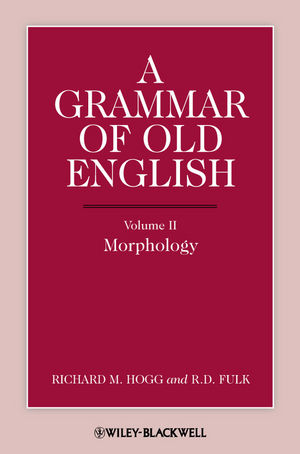A Grammar of Old English, Volume 2: MorphologyISBN: 978-0-631-13671-2
Hardcover
410 pages
February 2011, Wiley-Blackwell
 This is a Print-on-Demand title. It will be printed specifically to fill your order. Please allow an additional 10-15 days delivery time. The book is not returnable.
|
||||||
Preface x
Acknowledgments xii
List of abbreviations xiii
1 Preliminaries 1
2 Nouns: Stem Classes 7
I Early backgrounds (§§1–9) 7
II Vocalic stems (§§10–77) 14
1 a-stem nouns (§§10–33) 14
(a) Simple a-stems (§§11–18) 14
(b) ja-stems (§§19–26) 18
(c) wa-stems (§§27–33) 22
2 d-stem nouns (§§34 –54) 26
(a) Simple d-stems (§§35– 44) 26
(b) jd-stems (§§45–51) 32
(c) wd-stems (§§52– 4) 36
3 i-stem nouns (§§55–70) 37
4 u-stem nouns (§§71–7) 46
III Consonantal stems (§§78–114) 48
1 n-stem nouns (§§78–90) 48
(a) dn-stems (§§80–7) 49
(b) cn-stems (§§88–90) 54
2 r-stem nouns (§§91– 4) 55
3 s-stem nouns (§§95–101) 58
4 þ-stem nouns (§§102–3) 61
5 nd-stem nouns (§§104 –8) 62
6 Root-stem nouns (§§109–14) 64
3 Nouns: Declensions 69
I Introduction (§§1–6) 69
II as-declension (§§7–72) 72
1 Inflexions (§§8–11) 73
2 Allomorphic variation (§§12–72) 75
(a) Restoration of A (§§14 –17) 76
(b) Palatalization (§§18–20) 77
(c) Back umlaut (§§21– 4) 78
(d) Loss of [h] (§§25–9) 80
(e) Devoicing (§§30–1) 83
(f) Nominative singular in -e (§§32–8) 83
(g) Geminate consonants (§§39– 41) 86
(h) Nominative singular in -u (§42) 88
(i) Nominative singular in -w (§§43–9) 88
(j) Apocope (§§50–1) 92
(k) Double plurals (§§52–5) 93
(l) Disyllabic nouns (§§56–72) 95
III a-declension (§§73–104) 109
1 Inflexions (§§74 –80) 109
2 Allomorphic variation (§§81–104) 112
(a) Restoration of A (§§83– 4) 113
(b) Palatalization (§85) 114
(c) Back umlaut (§§86–7) 114
(d) Loss of [h] and final devoicing (§§88–9) 115
(e) Geminate consonants (§§90–1) 116
(f) Stem-final /w/ (§§92– 4) 117
(g) Apocope (§§95–9) 119
(h) Disyllabic nouns (§§100– 4) 122
IV an-declension (§§105–16) 124
1 Inflexions (§§106–15) 124
2 Allomorphic variation (§116) 129
V Minor declensions (§§117–31) 129
1 Minor a-plurals (§§117–21) 129
2 Mutation plurals (§§122–7) 132
3 Miscellanea (§§128–31) 136
VI Gender and declension (§§132– 43) 138
1 Gender (§§133–9) 138
2 Declension (§§140–3) 142
VII Nominal compounding (§§144 –7) 143
4 Adjectives, Adverbs and Numerals 146
I Introduction (§§1–3) 146
II Indefinite (strong) adjectives (§§4 –56) 147
1 Historical origins (§§4 –8) 147
2 Inflexions (§§9–20) 149
3 Allomorphic variation (§§21–56) 154
(a) Restoration of A (§§22– 4) 154
(b) Loss of [x] (§§25–30) 155
(c) Nominative singular in -e (§§31–5) 159
(d) Geminate consonants (§§36–7) 162
(e) Nominative singular masculine in -u (§§38–9) 162
(f) Nominative singular in -w (§40) 163
(g) Apocope (§§41–3) 164
(h) Disyllabic and polysyllabic stems (§§44 –52) 165
(i) Past participles (§§53–6) 171
III Definite (weak) adjectives (§§57–60) 172
1 Historical origins and inflexions (§§57–9) 172
2 Allomorphic variation (§60) 173
IV Comparison of adjectives (§§61–75) 174
1 Historical origins (§§61– 4) 174
2 Variation in Old English (§§65–75) 177
V Adverbs (§§76–9) 183
VI Numerals (§§80–91) 185
1 Cardinals (§§80–9) 185
2 Ordinals (§§90–1) 189
5 Pronouns 191
I Introduction (§§1–2) 191
II Demonstrative pronouns (§§3–13) 192
III The anaphoric pronoun (§§14 –17) 197
IV Interrogative pronouns (§§18–21) 200
V Personal pronouns (§§22–32) 202
VI Indefinite pronouns (§§33–7) 207
VII Other pronominal types (§§38–9) 209
6 Verbs 210
I Early background (§§1–5) 210
II Strong verbs (§§6–76) 213
1 Inflexions (§§6–30) 213
(a) Indicative present (§§11–20) 216
(b) Indicative preterite (§§21–2) 222
(c) Subjunctive (§§23–5) 223
(d) Imperative (§26) 224
(e) Non-finite forms (§§27–30) 224
2 Stems (§§31–76) 225
(a) Ablaut patterns (§§33–6) 227
(b) Variant stem types (§§37– 42) 231
(i) Weak presents (§37) 231
(ii) Contracted verbs (§§38– 41) 231
(iii) Alternations under Verner’s Law (§42) 234
(c) Classes of strong verbs (§§43–76) 234
(i) Class 1 (§§43–6) 234
(ii) Class 2 (§§47–50) 236
(iii) Class 3 (§§51–7) 239
(iv) Class 4 (§§58–60) 243
(v) Class 5 (§§61– 4) 246
(vi) Class 6 (§§65–8) 248
(vii) Class 7 (§§69–76) 251
III Weak verbs (§§77–130) 258
1 Weak class I (§§78–103) 258
(a) Inflexions (§§80–8) 260
(b) Stems (§§89–103) 265
(i) Stems with original geminate (§92) 266
(ii) Stems in dental consonant (§§93–5) 267
(iii) Stems in original final sonorant (§§96–8) 268
(iv) Contracted verbs with loss of [h] (§99) 272
(v) Stems in final velar consonant (§§100–3) 273
2 Weak class II (§§104 –20) 279
(a) Inflexions (§§106–13) 279
(b) Stems (§§114 –20) 284
3 Weak class III (§§121–30) 289
(a) Inflexions (§122–26) 290
(b) Stems (§§127–30) 294
IV Preterite-present verbs (§§131– 44) 299
1 Inflexion and classes (§§132– 40) 300
(a) Classes 1 and 2 (§§133– 4) 300
(b) Class 3 (§§135–6) 302
(c) Classes 4 and 5 (§§137–8) 303
(d) Classes 6 and 7 (§§139– 40) 305
2 Historical development (§§141– 4) 306
V Athematic verbs (§§145–63) 308
1 The verb bbon, wesan (§§146–51) 309
2 The verb ddn (§§152–5) 314
3 The verb gan (§§156–9) 317
4 The verb willan (§§160–3) 320
References 323
Word index 342
Subject index 383



